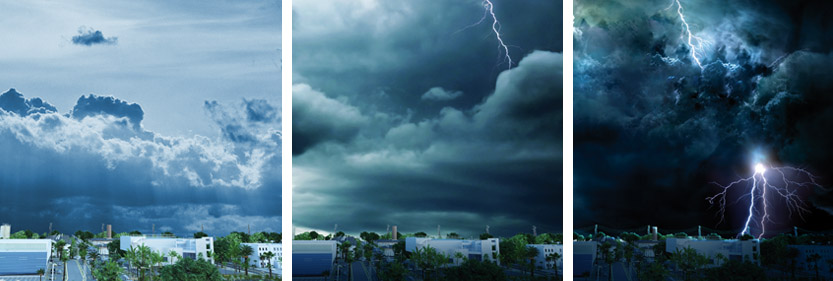In the last decades, technological innovation in the lightning protection matter has revolutionized the sector. Nowadays, we offer lightning protection systems really sophisticated, designed to increase the protection zone.
Before going into explaining the technology, its convenient to understand how the lightning rods where created and how they work.
What is a lightning rod and how it works?
A lightning rod is a device which protects people, buildings and installations from the lightning strike, it diverts lightning harmlessly into the ground.
Lightning rods work by attracting the beam to prevent it from hitting any object inside the protection area. These elements of external protection are formed by a metal object, generally peaked which is connected to a system of down conductors and grounding, which conduct the current safely and dissipate it.
History of lightning rods: Origins of the Franklin lightning rods
The first lightning rod was invented in 1749 by Benjamin Franklin in the United States, in his honor, it was called Franklin lightning rod.
The Franklin lightning rod is a really simple system base in a metal tip connected to the ground. Currently, it is still used alone or as part of a system of tips and meshes.
History of lightning rods: Types of lightning rods
In normal conditions, in the atmosphere there is a balance between positive and negative charges. But, during a thunderstorm, the lower part of the clouds has a negative charge which induces a positive charge on the earth and the elements above it.
From a certain level of electric field, the air ceases to be an insulator and the clouds are discharged onto the earth with an electric arc, which we call lightning. The object that forms the ascending plotter will be the one that will receive the impact of the beam. The cloud load will look for the most direct way to land, a path that, if not controlled, can cause serious damage.

There are two types of lightning protection systems, classified according to their operation mode.
- Passive lightning protection systems: Franklin rods and conductors are located in possible beam impact zones.
- Active lightning protection systems: They use early streamer emission air terminals which emit an ascending plotter in order to anticipate any other object within its protection area, thus becoming the controlled point of impact of the beam.
In both cases, once the beam is intercepted, down conductors and grounding are required to avoid damage due to lightning current. In the case of lightning rods with early streamer emission terminals, by having the impact spot controlled, the rest of the external system could be easier.
Lightning rods with early streamer emission (ESE): DAT CONTROLER® REMOTE
The lightning rod with early streamer emission has been one of the technological advancements in lightning protection. Its functioning is based in the electrical characteristics of the lightning formation, using the existing knowledge about the lightning physics, in order to cover a bigger surface area.
DAT CONTROLER® REMOTE
The DAT CONTROLER® REMOTE is the last product from Aplicaciones Tecnológicas related to lightning protection. DAT CONTROLER REMOTE offers the possibility of checking the state of the lightning rod in every moment and wherever you are. This innovation enables, not only the monitoring of the elements, it also saves time and maintenance cost of installation.
Installation of lightning rods with early streamer emission
The lightning rod with early streamer emission device need to be installed two meters above from any other element inside its radius of protection. For the fixation of the device they use masts and anchorages.
The DAT CONTROLER® REMOTE has a remote tester with solar panels, it is recommended to install it in a place where there is no shade and orientate the device towards the sun.
The ESE, as it happens with every other lightning protection system, it needs to have an installation of down conductors and a grounding system. Moreover, this technology of active lightning rods, can be combined with other protection mechanisms, such as the meshes. In this way, we ensure that the beam will be received with as much security as possible.
Its convenient to install a lightning counter, because the standard says it is needed to make an inspection in the lightning protection system when it has received an impact. AT LOGGER is an equipment that monitors the electrical activity of the down conductor, registering the amplitude and polarity of the current impulse, and the date and hour it happened.
Regulatory standards on lightning protection
Both lightning protection systems should fulfill their specific standard:
- The passive systems or with Franklin rods should be installed following the IEC 62305 standard “Lightning protection”.
- The active systems with ESE lightning rods should be installed following the UNE21186 standard “Structure protection, construction and open space with a ESE lightning rod” or equivalent (NF C 17102, NP 4426, …).
In addition of the installation, these norms should cover also the tests that the lightning rods need to go through to determine the parameter its characterized for: its time in advance.
In both cases, the conductors and other lightning protection elements need to compliment the requirements if the standard IEC 62561 “Requirements about the components of lightning protection”.
Before buying a lightning rod, plan your project with the CDRISK software which enable to calculate the risk the structure has taking into account the current standards, or consult our experts.
To be informed of the last innovations, subscribe our newsletter.
